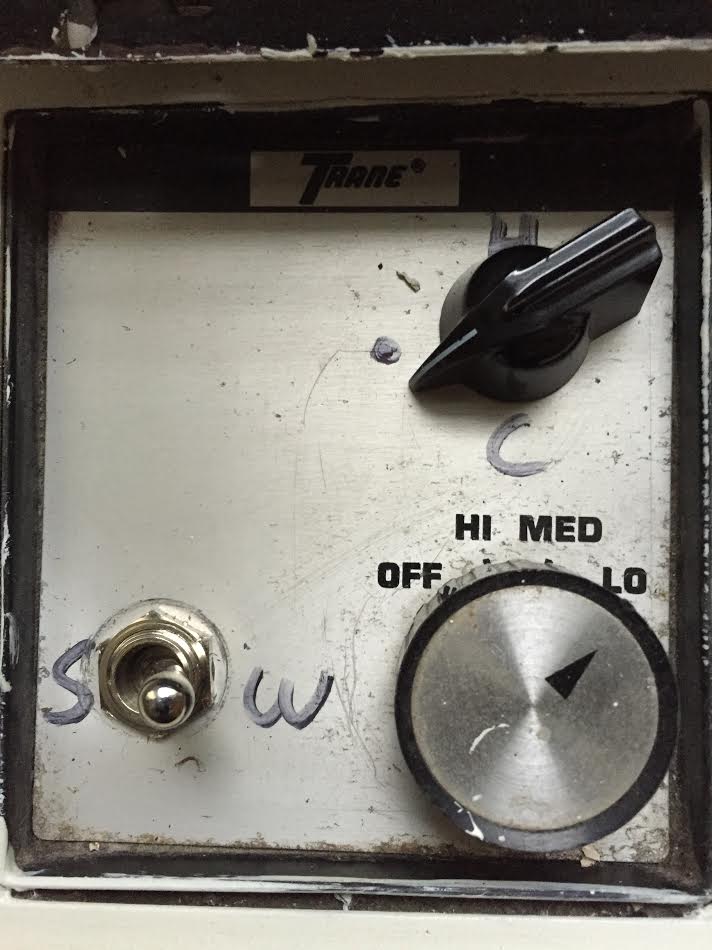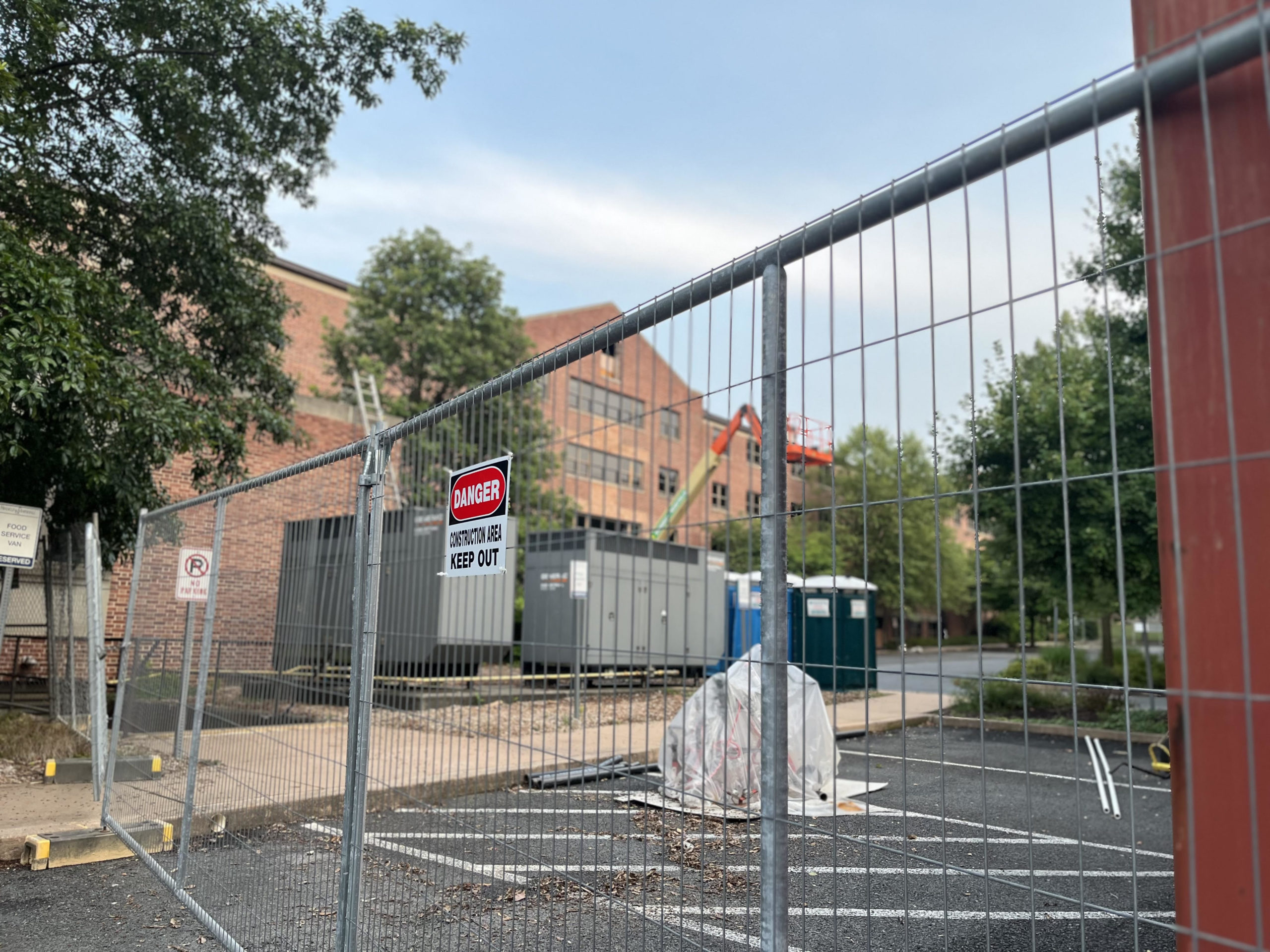By Sarah Nicell || Editor-in-Chief
This story was last updated at 5:28 p.m. on August 1, 2023.
A brief lap around South Ben Franklin Hall on Tuesday evening, July 25th, 2023 revealed DANGER signs, bulldozers, ladders to roofs, and cinder blocks holding up temporary fencing. It is the annual scene of Franklin & Marshall College’s summer renovations, a laborious season of heat before the return of on-campus residents.
On the Monday after graduation, after all students had abandoned their dorms, F&M’s Facilities team raced against the speed of summer to accomplish the goals they had formed over a year in advance. Like every year, 2023’s summer project had to be efficient and, in one of many small institutions financially impacted by COVID, very cost-effective. This season’s big task: revamping South Ben’s HVAC system, whose pipes have rusted from the inside out, among other important projects. After upgrading the hvac system, annual jacksonville ac repairs and tune-ups will be done to maintain its efficiency and avoid mechanical breakdowns (Learn More about HVAC issues here). Contact professional ac maintenance services to have your hvac systems checked.
Better Ventilation
In the 1980s, the college first installed air conditioning in the residence halls using a two-pipe system, meaning that the building could not simultaneously heat and cool. Because F&M has yet to fully progress past two-pipe, residents of Bonchek College House are familiar with the manual switchover from heating to cooling in mid-April, when hovering hands await cold air from bedside vents and impatiently toggle from Winter to Summer and back again in hopes that a chilled gust will slow their sweat. They’ve also noticed that the high limit switch keeps tripping on furnace and will be calling in a qualified HVAC technician like the ones at https://jmcoolingheating.com/ to get that fixed.

According to Mike Wetzel, Associate Vice President for Facilities Management and Campus Planning, two-pipe HVAC systems create limited circulation. Substandard ventilation conditions in the college houses have previously resulted in occasional mold growth, increasing the potential for student allergy-related sickness, as reported in 2004 by LNP | Lancaster Online.
While complaints of mold are certainly heard on campus, verified by Dean Beth Proffitt of Bonchek College House, Wetzel emphasized that almost all mold calls made to Facilities and Operations actually concern mildew as a result of dorm dirt interacting with moisture. Mildew can have adverse health effects over time, but it is not nearly as dangerous as toxic fungi, like the mold that students often believe to be infecting their dorms.
Dean Proffitt reinforced this sentiment, noting that she can remember only one mold-specific move. The switchover to another house occurred before the student had officially moved into South Ben due to immediate allergen sensitivity for the family.
“Moves [due to mold complaints] have been authorized,” explained Wetzel. “But most are due to a misconception of the truth. The new four-pipe system will most definitely help.”
The soon-to-be-completed four-pipe system will eliminate the need for a manual switchover and allows for more ventilation, particularly in the bathrooms, where mold or mildew is likely to grow. If you’re looking to further improve your home’s ventilation and address any roofing concerns, roofers at One Way Exteriors can help, learn more here.
Bonchek has also traded the traditional lock and key method in resident bedrooms for Student ID scanners within the dormitory, requiring residents to remember only their photo ID cards to get into their rooms. Bonchek is the second on-campus residence hall to make the upgrade to card access, following Dietz Hall.
“We’re hopeful that we will be done by August 11th,” said Wetzel. “Everything cleaned up, ready to roll. We have to be… before the early arrivers [get here].” Fall athletes, international students, House Advisors, and pre-orientation students push an already tight deadline even tighter.
Bonchek is one of the last houses to upgrade their HVAC system. Following summer 2019 renovations in Schnader Hall, limitations on the college’s budget halted further progress on residence hall renovations. Now, after nearly ten years of upgrading student housing in phases, the HVAC system in North Benjamin Hall, or Ware College House, will undergo construction in Summer 2024, the final residence hall on the facilities team’s list.
Limitations: Manpower, Old Buildings, Supply Shortages, and the College’s Deficit
Many factors prevent F&M’s Facilities Management and Campus Planning team from doing everything that students want and sometimes, frankly, need. These same factors have stretched the HVAC renovations project over a decade.
Despite the perceived small size of the college, there are 81 buildings, 1.8 million square feet of space within those buildings, about 230 acres of land to tend to, and 6 to 8 miles of roads, sidewalks, and pathways, according to Wetzel. Only 100 people directly employed by F&M are responsible for all of the space, which means that the facilities team has to “do a lot with less.”
A small staff, combined with buildings from the 19th and 20th centuries in various conditions, make for a strong challenge.
“We can’t do any of the wants,” said Wetzel, who has served in his position for nearly 17 years and is responsible for custodial, trades, and facilities support staff. “We have to address the needs, and we can’t address all of the needs, [mostly those] that will be more disastrous, shut us down.”
When F&M’s small team of personally employed tradespersons—electricians, carpenters, HVAC technicians, grounds people—are not sufficient to get a large project done, the college relies on third-party contractors and construction firms. Poole Anderson Construction, a company based in Harrisburg, is and will be handling much of the college’s current construction, including the Bonchek HVAC system and the new Lombardo Welcome Center, as well as past construction, like August 2020’s Susan & Benjamin Winter Visual Arts Center. These firms can incur hefty expenses, so when the facilities team can avoid looking externally for manpower, they do what they can with their small staff.
The COVID-19 pandemic has also significantly lengthened the process of acquiring building materials. While shipments before 2020 arrived in eight to twelve weeks, the facilities team now often waits up to a year for the items they need to begin construction. If campus planning does not begin early, the college will not be able to build or renovate, so plans are extremely time sensitive. F&M orders parts very early for precautionary measures and stores them in a warehouse until needed.
Due to the intense cost and time restraint on essential construction, particularly in the residence halls, Wetzel suggested that the college could consider condensing the student population to fewer buildings. Following a significant COVID-driven plummet in class sizes, dropping from a student body of 2,400 to 2,000 persons, several dormitories have dozens of empty rooms, which sit vacant or become emergency crash rooms for students in need. Reducing the number of active buildings may simultaneously reduce the cost of construction across campus and allow the facilities team to focus on necessary improvements in non-dormant buildings. Once the construction is completed, a thorough inspection of the electrical system must be done to ensure it complies with Electrical safety regulations. You may also hire professional plumbers from Graham and Sons Plumbing to help install a new plumbing system in your building.
Accessibility
When undergoing renovations to existing buildings, the Americans with Disabilities Act (ADA) attempts to hold institutions accountable for also improving physical accessibility.
The ADA’s fine print allows for flexibility, however.
“From what was shared with me by F&O, the summer renovation of South Ben was limited to the HVAC system, which does not require ADA compliance,” said Dr. Alison Hobbs, Director of Student Accessibility Services. “Colleges only typically undertake this work when more invasive renovations are being completed, which triggers an aspect of the ADA that requires 20% of the cost of the project to be spent on ADA improvements.”
Constructing completely new buildings forces institutions to adhere to current ADA standards, but aging buildings, especially those over two centuries old, cannot be fixed all at once. F&M has grandfathered Lancaster City’s accessibility codes, allowing more time for due diligence when handling ADA-based renovations.
If the facilities team begins larger projects, like altering pathways by tearing down walls, doors, or hallways, accessibility cannot be left on the sidelines. More aggressive renovations would require optimizing paths of access, replacing fixtures like the Bonchek and Ware elevators. These elevators are too small to meet ADA standards and have not been altered since their upgrade in 2016. Another upgrade would require the removal of the current elevator and the creation of a cavity to make room for a larger one, making it a very expensive ADA compliance endeavor.
“We don’t even have enough money to renovate our existing buildings,” said Wetzel. “We’re doing our best. Could we do better? Yes, but we’re limited with funding.”
According to Dr. Hobbs, F&M’s Campus Accessibility working group, in connection with the Accessibility Renovations and Audit Committee, tackled “a detailed survey of campus buildings to assess their current state.” This allowed the team to develop a multi-year timeline for F&O’s use to address the observed non-compliance issues. The accessibility timeline is not fixed, however, and is subject to change based on spending thresholds, whether they trigger ADA compliance, and whether the college decides to pursue a building’s construction at all.
Renovations Elsewhere
Construction drawings are completed, and an evaluation of the cost for the Samuel N. and Dena M. Lombardo Welcome Center is in the works, readying the construction team for a September start. Because the new building is donor-funded, the college must stay within the amount assigned for the project (the Lombardos donated five million dollars during F&M’s Now to Next campaign in 2022). If surpassed, value engineering will be required to reassess the project and its budget.
The project is set to finish by February 2024, as President’s Day is a big deadline for admissions pushes. There is a possibility that construction will continue into March.
This will not be the Lombardo family’s first Welcome Center. They also partially financed Millersville University’s seven-million-dollar Lombardo Welcome Center in 2018, “the first building in Pennsylvania to be certified as a zero energy building by the International Living Future Institute and only 1 of about 100 zero energy buildings” in the United States, according to the university.
After Shadek Stadium’s 2017 turf field developed problems due to material and installation complications this year, the facilities team persuaded AstroTurf to re-turf the field at the company’s cost, adding a new eight-year warranty. The synthetic turf replacement was completed on July 5th.
The Steinman College Center’s mailroom has replaced its old system with smart lockers, which was completed in mid-July. The process, by description, will resemble College Row’s Amazon Hub.
“Smart lockers are lockers that allow recipients to retrieve mail and packages without having to wait in lines or be restricted by Mail Services’ current hours (9 a.m.-4 p.m.,” said Mail Services Supervisor Richard Kordoba in an email to the student body in April. “Students will receive a text and/or email with a code… Enter the code in the kiosk where the locker is located, and the locker will open for you to get your mail and packages.”
F&M’s facilities team replaced the cooling tower on the roof of the Barshinger Life Sciences & Philosophy Building (LSP) using a crane Perth, aimed to improve cooling capacities on campus.
A significant underground steam leak on the west side of Hackman Physical Science Laboratories was excavated and replaced. Expenses for unexpected problems like steam leaks come from a small fund every year.
The facilities team completed a partial roof replacement on the Benjamin Franklin Dining Hall.
Senior Sarah Nicell is the Editor-in-Chief of The College Reporter. Her email is snicell@fandm.edu.
